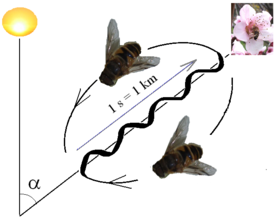
I have seen the honey bee dance that is used by bees to tell each other how to find flowers. A bee returns to the hive with a load of nectar and dances around in a circle and then moves, wagging back and forth in the direction of the source of the nectar. The bee will indicate the direction and the distance to the flowers by the details of the dance.
There has been a great deal of discussion about the details of the waggle dance. The bee, it might appear, does not have a brain big enough to communicate the information to other bees and other bees don’t have a brain big enough to understand the dance. There are those that claim that the neurons in the bee’s brain are not complex enough for such behavior.
Yet the bees dance.
Neural nets can very easily aspire to “emergent” behaviors. The bee has a great variety of emergent behaviors. They care for their young, the queens go on mating flights, bees swarm and send out scouts to find a new home. They have dozens of chemicals which communicate things like the needs of the queen, the condition of the hive, and danger. These behaviors are not learned, but can be refined by experience. The basic rules of behavior, transmitted to the bees through their DNA, are probably very simple, but result in complex behavior.
Emergent complex behaviors which are base on simple rules written in DNA, are rampant in life. The thing about the bees is that the behavior is so precise. It almost appears as though the bees are doing arithmetic and much of the discussion has centered around whether or not bees can count up to five or 8. Of course, the bees can’t count. The process is not digital at all, but analog. The bees can feel that 5 wags of another bee’s tail is more than 4 wags, and they “get a feel” for the distance based on how impressed they were by the degree of wagging. The bee doing the dance does not know the distance to the flowers, she just has a feel for how hard it was to fly the distance and correlates that to the number of waggles in her dance.
Bees have tiny brains and their neurons are counted in the hundreds of thousands, as apposed to a human brain which has billions of neurons. Those thousands of neurons each has many connections so that the total number of neural paths numbers into the tens of millions, and very simple rules can result in very complex behavior. Add to that the ability of a bee to learn and remember simple things and their behavior is amazingly intelligent.
Now think about man’s brain. We already have computers which are approximately the raw computing power of a human brain. Computers rival the human brain in complexity and simply blow away the brain in speed. Yet, there is no indication that computers are becoming intelligent in the same way that a human brain is intelligent. The machines can compute, but they can’t think.
The reason why we haven’t created a thinking machine has nothing to do with the hardware. Computers are far superior to the human brain in the hardware department. Thought, Intelligence, Conscience, and Soul are emergent behaviors, based on a large number of inherited and simple rules that are written in our DNA. The raw structure of the brain is a vehicle for letting these rules interact. We can examine the brain structurally and mimic some of the things that it does, but until we discover those basic rules of intelligence, computers will be dumb servants.
On the other hand, it is quite possible that computers will develop their own DNA, so to speak, in the form of operating systems, programs, apps and databases. It is possible that a machine may wake up some day. Perhaps someone will map the basic structural rules of the brain and translate some of them to computer algorithms. These may allow the computers to evolve into something else. This may even happen in our own lifetimes.
The honey bee is a model that can be used to understand emergent behavior. There are surprisingly few neurons in the brain of a honey bee and it is possible and probably not very difficult to model their behavior. It may be possible, before very long to completely understand how the basic rules of computing that a honey bee inherits can be translated into the complex behavior of the waggle dance. When we can do that, it will not be long before we can start understanding the basic rules that allow a human to know, understand and think.